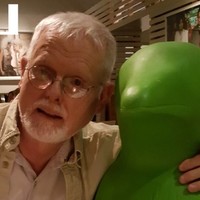Papers by Adnan Mahmutovic
The Coleridge Bulletin, Jan 1, 2007
Iconized migrant writers such as Michael Ondaatje, Salman Rushdie and Ben Okri use their fictiona... more Iconized migrant writers such as Michael Ondaatje, Salman Rushdie and Ben Okri use their fictional worlds to articulate the ways in which existential nervous conditions, caused by violent postcolonial history, drive individuals to rework the critical notions of freedom, authenticity and ...
The Journal of Contemporary Literature, Jan 1, 2009
SwePub titelinformation: History and the Nervous Condition in The English Patient.
Literary Magic, Jan 1, 2008
SwePub titelinformation: Lars von Trier's Gift [Elektronisk resurs].
Literary Magic Magazine, Jan 1, 2007
SwePub titelinformation: Literature on my Mind.
Books by Adnan Mahmutovic

Inside this book bursts a kaleidoscope of characters in historical settings from the Balkans to S... more Inside this book bursts a kaleidoscope of characters in historical settings from the Balkans to Scandinavia, which they seek to escape, fit in, or change. Following a few female leads after they leave war-torn Bosnia, this book compresses simmering emotions ranging from loss, fear, love, hate, revenge, displacement, regret, humor, and hope. Almasa, the main character in most stories, is feisty and funny, and she suffers no fools. She will go to any length to take charge of her broken life and avoid being labeled a victim. Fatima is like her subtler sister, but no less determined to turn the tables on her horrible fate. In between them are pieces of the author's life, as fictionalized as the lives of the two women are real. Each story, although compact and unique on its own, is tied to all other stories, chronologically, emotionally, or thematically. Together they probe the margins of our contemporary history and give voice to people pushed to the edge of life.

Iconic migrant writers such as Michael Ondaatje, Salman Rushdie and Ben Okri use their fictional ... more Iconic migrant writers such as Michael Ondaatje, Salman Rushdie and Ben Okri use their fictional worlds to articulate the ways in which existential "nervous conditions," caused by violent postcolonial history, drive individuals to rework the critical notions of freedom, authenticity and community. This existential thread in their works has been largely ignored or left undeveloped in criticism. Although Rushdie has argued that they primarily write back to the imperial centre(s), in their signature novels, The English Patient, Midnight's Children and The Famished Road, they respond to their conflicting cultural and ethnic heritages by dramatizing characters in traumatic struggles with belonging and affiliation. As a way of coping with their identity crises, most characters succumb to the political rhetoric of communalism. The central characters, however, are driven by a powerful desire for self-sufficiency. Yet, since this individualism clashes with their need for communal sharing, they enact a form of creative destruction of their singular selfhood and communal identity. They experience a certain plurality of singular selfhood and participate in forms of "inoperative communities," which elicit bonds without ties and coexistence without the necessity of a common work and essence.
Journal Articles by Adnan Mahmutovic

ImageText: Interdisciplinary Comics Studies, Aug 2015
The comic book writer Grant Morrison has addressed the question of the animal repeatedly througho... more The comic book writer Grant Morrison has addressed the question of the animal repeatedly throughout his career, most notably in The Filth, WE3, and the earlier series which is the focus of this paper, Animal Man. Given that comic’s clear engagement with the theme of animal rights, it is odd, as Marc Singer notes, that critics have largely analysed it only as metafiction. This article seeks to readdress this, with particular reference to Jacques Derrida’s The Animal That Therefore I Am and David Herman’s work on the representation of animal experience in graphic narratives. It might be expected that Animal Man would provide an example of “how the representation of what it is like for (nonhuman) characters to experience events is shaped by medium-specific properties of graphic narratives” (Herman), but Morrison and artist Chas Truog seem unwilling or unable to exploit the multimodality of comic narratives to deliver an exploration of animals’ worlds. Instead, it emerges, it is exactly Morrison’s use of metafiction which provides his most profound insights into animal experience and animal suffering, because the path which leads to Animal Man’s discovery that he is a comic book character also renders him powerless, and deprives him, like the animal, of speech, an experience of death, mourning, technics, laughter, and crying. This article concludes, therefore, that Morrison’s series dramatises what living is for animals and humans, and exemplifies what Derrida describes as the radical “possibility of sharing the possibility of this nonpower” as Animal Man becomes Animot Man.











Uploads
Papers by Adnan Mahmutovic
Books by Adnan Mahmutovic
Journal Articles by Adnan Mahmutovic